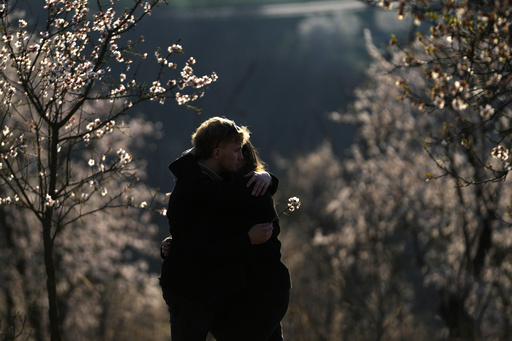HUSTOPECE, Czech Republic (AP) — Masses of white and pink blossoms in a rare almond grove in the Czech Republic appeared earlier than usual after one of the warmest winters on record.
The almond trees are usually among the first to bloom at the beginning of spring, on the turn of March to April, in this southeastern corner of the Central European country.
It was more than two weeks earlier this year when crowds of people came to admire the rows of flowering trees in a most unexpected place.
Almond-growing areas include California, the countries around the Mediterranean Sea, Chile and Australia. But the Czech Republic, given its colder climate, is definitely the odd one out.
Mild winters are not harmful for the blossoms here, but freezing temperatures are.
“It really is nothing out of the ordinary,” Katerina Kopova said on Tuesday about the early blossoms.
Kopova is the owner of a local family firm that makes various products from almonds, including alcoholic and non-alcoholic beverages, and helps maintain and develop the grove.
“We had a similar situation five years ago. But of course, there’s a risk of frost,” she said. “Today, we’re a little nervous because the forecast is expecting temperatures below zero and a couple of freezing mornings would be enough to end up with no harvest.”
The orchard on a hill near the vineyards above the town of Hustopece was established during the Cold War, soon after the communists took power in Czechoslovakia in 1948.
Behind the Iron Curtain, there was a significant shortage of goods from the West, from bananas to almonds. Communist states’ currencies were not convertible and the struggling command economies failed to produce enough decent goods to sell in exchange for hard currency.
The goal was to grow enough almonds for the entire Czechoslovakia to be self-sufficient. After the war, Czechoslovakia imported some 300 train carriages of almonds a year.
Experts identified a hill location with a slope facing south near Hustopece with one of the warmest climates in the country as the ideal place while various cultivars were tested to ensure the best possible harvest.
By 1960, the grove had some 50,000 trees covering an area of some 185 hectares, a rarity in Central Europe.
The almonds were used by a chocolate factory and elsewhere but the size of the grove was significantly reduced in the 1970s due to low production. Apricot trees, more common in Hustopece, were planted there instead.
The 1989 Velvet Revolution toppled the Communist regime and meant the final blow for the grove as the market was flooded with almonds from other parts of the world.
Some 15 years ago, students from local schools discovered that the town had something extraordinary, and encouraged the town hall to acquire the neglected property.
Today, the nearly 2,000 almond trees blooming in the former grove have become a popular spot for locals — and a tourist attraction.
“There have never been so many people here,” said Lukas Vitovsky, a visitor from the nearby city of Brno.
The grove is open all year long with many also visiting in the fall to collect the almonds that fall from the trees.
The place is not just “a reminder of history and a place for people to enjoy themselves,” said Kopova, but also to learn something because “many people don’t know what an almond in a shell looks like.”



